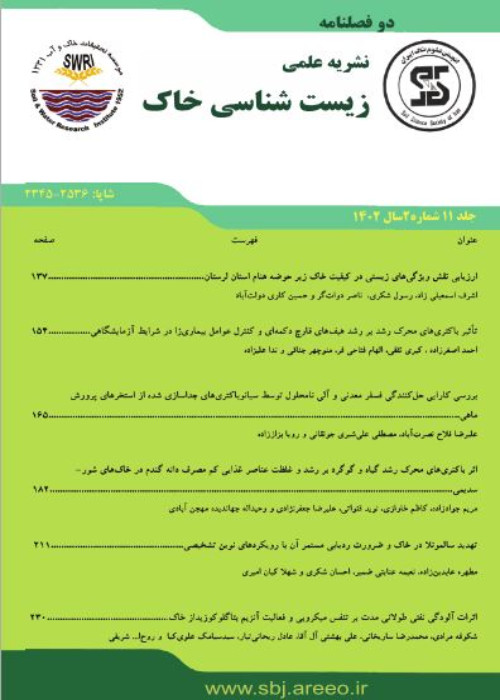Effect of biological fertilizers and different weed control methods on improvement of growth and yield of chickpea (Cicer arientinum L.)
Using biofertilizers and weed control can be effective on improving of chickpea yield. In this study, a factorial experiment was conducted in a RCBD with three replications at Ferdowsi University of Mashhad. Experimental Factors included the application of biofertilizers in six levels (phosphate solubilizing bacteria (Bacillus +Pseudomonas), potassium solubilizing bacteria (Thiobacillus sp.), pseudo-mycorrhizae (Piriformospora indica), Bacillus + Pseudomonas + Thiobacillus , Bacillus + Pseudomonas + Thiobacillus + Piriformospora, and control treatment) and weeds control at three levels (weed control with combination of pyridate and cletodim herbicides, two and three times weeding). Results showed that the distance of the first branch from the soil surface was not affected by biological fertilizers and weed control treatments although it was increased with application of biological fertilizers. The highest pod distance from the soil surface was observed in phosphate solubilizing bacteria + two weeding treatment. The maximum number of main branches per plant was obtained in phosphate solubilizing + two weeding treatment. The highest number of lateral branches per plant was observed in potassium solubilizing bacteria treatment + phosphate solubilizing bacteria + weed control using combination of pyridate and cletodim herbicides. Concomitant using of potassium solubilizing bacteria with phosphate solubilizing bacteria increased the number of pods per plant by 30% compared to the control treatment.There were no significant differences between chemical and weeding of weed control treatments in terms of number of pods per plant. Concomitant consumption of potassium + phosphate solubilizing bacteria and concomitant application of potassium + phosphate solubilizing bacteria along with endophytic fungi mycorrhiza produced the highest chichpea biomass and seed yield. The application of pyridate + cletodim herbicides reduced seed yield to 29 and 24 percent, respectively, compared with two and three times weeding. The highest concentration of shoot phosphorus was obtained in the treatment of endophytic fungi and chemical control of weeds and the highest concentration of potassium was obtained in the combination treatment of potassium and phosphate solubilizing bacteria and endophytic fungi. Generally, in this study biological fertilizers had a positive effect on yield and yield components of chickpea, although the application of combination of pyridate and cletodim herbicides had a negative effect on chickpea yield.
- حق عضویت دریافتی صرف حمایت از نشریات عضو و نگهداری، تکمیل و توسعه مگیران میشود.
- پرداخت حق اشتراک و دانلود مقالات اجازه بازنشر آن در سایر رسانههای چاپی و دیجیتال را به کاربر نمیدهد.


